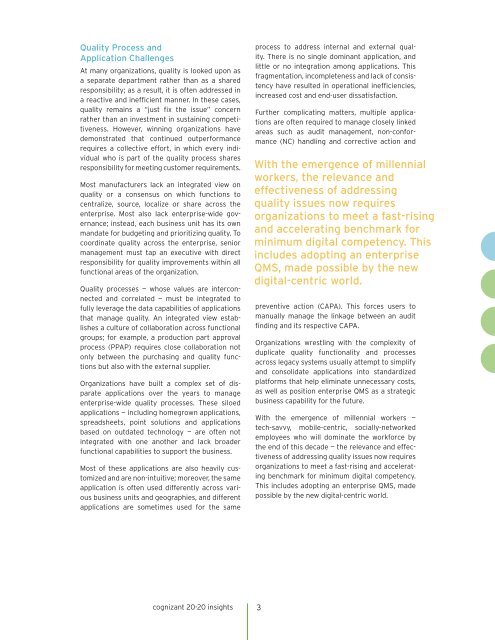• Decoding Quality Management Systems
1RF8NS1
1RF8NS1
Create successful ePaper yourself
Turn your PDF publications into a flip-book with our unique Google optimized e-Paper software.
<strong>Quality</strong> Process and<br />
Application Challenges<br />
At many organizations, quality is looked upon as<br />
a separate department rather than as a shared<br />
responsibility; as a result, it is often addressed in<br />
a reactive and inefficient manner. In these cases,<br />
quality remains a “just fix the issue” concern<br />
rather than an investment in sustaining competitiveness.<br />
However, winning organizations have<br />
demonstrated that continued outperformance<br />
requires a collective effort, in which every individual<br />
who is part of the quality process shares<br />
responsibility for meeting customer requirements.<br />
Most manufacturers lack an integrated view on<br />
quality or a consensus on which functions to<br />
centralize, source, localize or share across the<br />
enterprise. Most also lack enterprise-wide governance;<br />
instead, each business unit has its own<br />
mandate for budgeting and prioritizing quality. To<br />
coordinate quality across the enterprise, senior<br />
management must tap an executive with direct<br />
responsibility for quality improvements within all<br />
functional areas of the organization.<br />
<strong>Quality</strong> processes — whose values are interconnected<br />
and correlated — must be integrated to<br />
fully leverage the data capabilities of applications<br />
that manage quality. An integrated view establishes<br />
a culture of collaboration across functional<br />
groups; for example, a production part approval<br />
process (PPAP) requires close collaboration not<br />
only between the purchasing and quality functions<br />
but also with the external supplier.<br />
Organizations have built a complex set of disparate<br />
applications over the years to manage<br />
enterprise-wide quality processes. These siloed<br />
applications — including homegrown applications,<br />
spreadsheets, point solutions and applications<br />
based on outdated technology — are often not<br />
integrated with one another and lack broader<br />
functional capabilities to support the business.<br />
Most of these applications are also heavily customized<br />
and are non-intuitive; moreover, the same<br />
application is often used differently across various<br />
business units and geographies, and different<br />
applications are sometimes used for the same<br />
process to address internal and external quality.<br />
There is no single dominant application, and<br />
little or no integration among applications. This<br />
fragmentation, incompleteness and lack of consistency<br />
have resulted in operational inefficiencies,<br />
increased cost and end-user dissatisfaction.<br />
Further complicating matters, multiple applications<br />
are often required to manage closely linked<br />
areas such as audit management, non-conformance<br />
(NC) handling and corrective action and<br />
With the emergence of millennial<br />
workers, the relevance and<br />
effectiveness of addressing<br />
quality issues now requires<br />
organizations to meet a fast-rising<br />
and accelerating benchmark for<br />
minimum digital competency. This<br />
includes adopting an enterprise<br />
QMS, made possible by the new<br />
digital-centric world.<br />
preventive action (CAPA). This forces users to<br />
manually manage the linkage between an audit<br />
finding and its respective CAPA.<br />
Organizations wrestling with the complexity of<br />
duplicate quality functionality and processes<br />
across legacy systems usually attempt to simplify<br />
and consolidate applications into standardized<br />
platforms that help eliminate unnecessary costs,<br />
as well as position enterprise QMS as a strategic<br />
business capability for the future.<br />
With the emergence of millennial workers —<br />
tech-savvy, mobile-centric, socially-networked<br />
employees who will dominate the workforce by<br />
the end of this decade — the relevance and effectiveness<br />
of addressing quality issues now requires<br />
organizations to meet a fast-rising and accelerating<br />
benchmark for minimum digital competency.<br />
This includes adopting an enterprise QMS, made<br />
possible by the new digital-centric world.<br />
cognizant 20-20 insights 3



